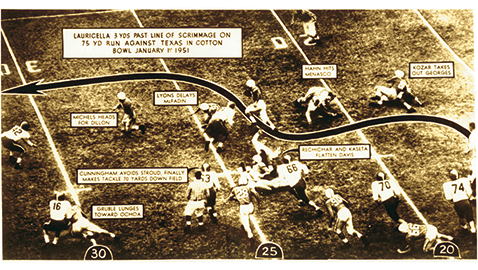By Tom Mattingly
What is the greatest run in Tennessee football history?
Opinions vary.
If Hank Lauricella’ s 75-yard run in the first quarter of the 1951 Cotton Bowl game against Texas is No. 1, Johnny Butler’s run against Alabama in 1939 is 1a, and Jay Graham’s touchdown runs against Alabama in 1995 and 1996 have to 1b and 1c. Steve World’s 82-yard carry against Vanderbilt in 1969 that came ever-so-close to being a touchdown is equally compelling. All of them have a logical basis for being so honored.
Sports Illustrated has called Lauricella’s run “arguably the best in Cotton Bowl history.” The tape of that run taken from the game film is black and white and grainy, obviously showing the effects of the passage of time, but it’s a significant part of Tennessee football history. It came in a game with Tennessee being ranked No. 4 nationally against Texas, ranked No. 3.
This run, showing the precision blocking at the line of scrimmage and downfield, set up Tennessee’s first score. If ever a picture summarized the offensive philosophy behind the single-wing, this is the one.
Here’s the way BC radio’s Bill Stern described Lauricella’s run. It’s Tennessee’s ball, first and-10, at the Vol 20. The game was scoreless.
“Single-wing right. Hank Lauricella is the tailback. He’s going outside his own right end. He’s up to the 25, the 30, into the clear at the 35, the 40, the 45, the 50, down to the 45.
“He’s hemmed in at the 43 [NOTE: How good was Bill Stern? He’s followed Lauricella every five yards, yet is able to note exactly where he was “hemmed in.”], gets away, down to the 25.
“He’s still running. He’s down to the 20, reverses his field once more to the 15, the 10, and he’s finally knocked down at the 5-yard line by Harley Sewell.”
But that wasn’t all. Stern quickly brought the run into context, showing the insight that made him one of radio’s greatest play-by-play men ever.
“Hank Lauricella went 85 [actually 75] yards for Tennessee, and time is out. Hank Lauricella went 85 yards. He started on his own five [actually the 20], zigzagged all the way up the field. He was almost out of bounds on two occasion. It looked like they had him pinned against the sidelines. Each time, he did a tightrope act. Stayed in bounds and, at the 30, it looked like the whole Texas team had a shot at him. He got down to the five, and Harley Sewell got him.”
More perspective.
“It’s first-and-five and, believe me, wait ‘til you see that run on the newsreels. That was a thriller. He did a tightrope act on the sideline that would make any tightrope walker jealous and, when he got to the center of the field, he broke into the clear about the 50, started zigzagging on the 40. Since he was zigzagging and they were running straight, they could overtake him.
“They hit him from behind on about the 40, and somehow he managed to elude the grasp of four Texans. He completely reversed his field, spun on a dime, handed them eight cents in change, cut toward the center of the field, and again burst into the clear at the 25. He eluded three more men and got down to the five and Harold [Herky] Payne has taken his place.”
That run, followed by a fourth-down touchdown pass from Payne to end John Gruble, gave the Vols a 7-0 lead. Even with the TD pass, Payne, who died this past March, didn’t play much the rest of the day. Over the years, Vol center Bob Davis took great delight in sharing Herky’s reaction.
“Threw for one, through for the day,” Davis recalled Herky saying.
The game is a classic in the history of Tennessee football, with a memorable run, and a stirring fourth quarter comeback.
The Vols trailed at the half, but rallied in the fourth quarter behind two Andy Kozar touchdown runs and an interception and fumble recovery by Maryville’s Jimmy (Cowboy) Hill. Lauricella and Kozar have each been inducted into the Cotton Bowl Hall of Fame.
Kozar and Davis have also told the story about the University of Texas band marching past the Vol dressing room before the game, playing the “Eyes of Texas.” Ever the master psychologist, Neyland told the Vols that, after the game, the song of choice would be the “Tennessee Waltz.”
“Outweighed 25 pounds per man but never outgamed,” wrote Haywood Harris and Gus Manning (“Six Seasons Remembered: The National Championship Years of Tennessee Football”). The Vols ended up winning on a rainy day in “Big D.”







